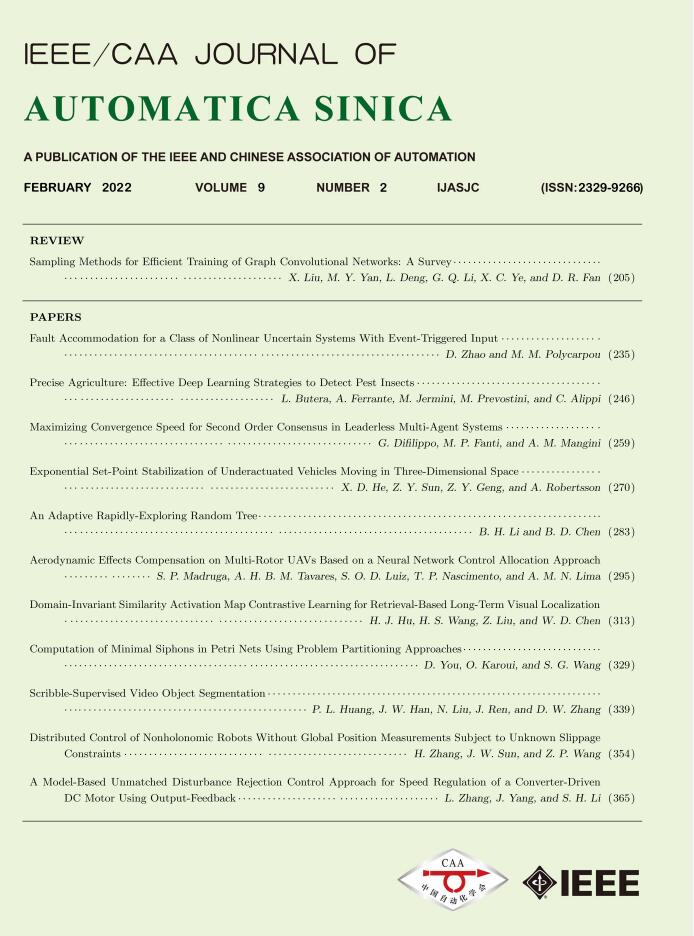 Volume 9
Issue 2
Volume 9
Issue 2
IEEE/CAA Journal of Automatica Sinica
| Citation: | B. H. Li and B. D. Chen, “An adaptive rapidly-exploring random tree,” IEEE/CAA J. Autom. Sinica, vol. 9, no. 2, pp. 283–294, Feb. 2022. doi: 10.1109/JAS.2021.1004252 |

| [1] |
L. E. Kavraki, P. Svestka, J. Latombe, and M. H. Overmars, “Probabilistic roadmaps for path planning in high-dimensional configuration spaces,” IEEE Trans. Robotics and Automation, vol. 12, no. 4, pp. 566–580, 1996. doi: 10.1109/70.508439
|
| [2] |
S. M. Lavalle, “Rapidly-exploring random trees : A new tool for path planning,” Iowa State University, Tech. Rep. 98-11,Oct. 1998.
|
| [3] |
X. Tang and F. Chen, “Robot path planning algorithm based on bi-rrt and potential field,” in Proc. IEEE Int. Conf. Mechatronics and Automation (ICMA), 2020, pp. 1251–1256.
|
| [4] |
C. Yuan, W. Zhang, G. Liu, X. Pan, and X. Liu, “A heuristic rapidlyexploring random trees method for manipulator motion planning,” IEEE Access, vol. 8, pp. 900–910, 2020. doi: 10.1109/ACCESS.2019.2958876
|
| [5] |
W. Xinyu, L. Xiaojuan, G. Yong, S. Jiadong, and W. Rui, “Bidirectional potential guided RRT* for motion planning,” IEEE Access, vol. 7, pp. 95046–95057, 2019. doi: 10.1109/ACCESS.2019.2928846
|
| [6] |
H. Zhang, Y. Wang, J. Zheng, and J. Yu, “Path planning of industrial robot based on improved RRT algorithm in complex environments,” IEEE Access, vol. 6, pp. 53296–53306, 2018. doi: 10.1109/ACCESS.2018.2871222
|
| [7] |
A. Tahirovic and M. Ferizbegovic, “Rapidly-exploring random vines (RRV) for motion planning in configuration spaces with narrow passages,” in Proc. IEEE Int. Conf. Robotics and Automation (ICRA), 2018, pp. 7055–7062.
|
| [8] |
J. J. Kuffner and S. M. LaValle, “Rrt-connect: An efficient approach to single-query path planning,” in Proc. ICRA Millennium Conf. IEEE Int. Conf. Robotics and Automation, 2000, vol. 2, pp. 995–1001.
|
| [9] |
D. Hsu, Tingting Jiang, J. Reif, and Zheng Sun, “The bridge test for sampling narrow passages with probabilistic roadmap planners,” in Proc. IEEE Int. Conf. Robotics and Automation (ICRA), 2003, vol. 3, pp. 4420–4426.
|
| [10] |
A. Yershova, L. Jaillet, T. Simeon, and S. M. LaValle, “Dynamicdomain RRTs: Efficient exploration by controlling the sampling domain,” in Proc. IEEE Int. Conf. Robotics and Automation (ICRA), 2005, pp. 3856–3861.
|
| [11] |
S. Khanmohammadi and A. Mahdizadeh, “Density avoided sampling: An intelligent sampling technique for rapidly-exploring random trees,” in Proc. Eighth Int. Conf. Hybrid Intelligent Systems, 2008, pp. 672–677.
|
| [12] |
Liangjun Zhang and D. Manocha, “An efficient retraction-based RRT planner,” in Proc. IEEE Int. Conf. Robotics and Automation (ICRA), 2008, pp. 3743–3750.
|
| [13] |
S. Rodriguez, S. Thomas, R. Pearce, and N. M. Amato, “RESAMPL: A region-sensitive adaptive motion planner”, Algorithmic Foundation of Robotics VII. Berlin, Heidelberg: Springer, 2008, pp. 285–300.
|
| [14] |
A. Shkolnik and R. Tedrake, “Sample-based planning with volumes in configuration space,” arXiv preprint arXiv:1109.3145, 2011.
|
| [15] |
M. Strandberg, “Augmenting RRT-planners with local trees,” in Proc. IEEE Int. Conf. Robotics and Automation (ICRA), 2004, vol. 4, pp. 3258–3262.
|
| [16] |
Rodriguez, Xinyu Tang, Jyh-Ming Lien, and N. M. Amato, “An obstaclebased rapidly-exploring random tree,” in Proc. IEEE Int. Conf. Robotics and Automation (ICRA), 2006, pp. 895–900.
|
| [17] |
S. Dalibard and J.-P. Laumond, “Linear dimensionality reduction in random motion planning,” Int. J. Robotics Research, vol. 30, no. 12, pp. 1461–1476, 2011. doi: 10.1177/0278364911403335
|
| [18] |
J. Lee, O. Kwon, L. Zhang, and SE. Yoon, “SR-RRT: Selective retraction-based RRT planner,” in Proc. IEEE Int. Conf. Robotics and Automation (ICRA), 2012, pp. 2543–2550.
|
| [19] |
W. Wang, L. Zuo, and X. Xu, “A learning-based multi-RRT approach for robot path planning in narrow passages,” J. Intelligent &Robotic Systems, vol. 90, no. 1−2, pp. 81–100, 2018.
|
| [20] |
T. Lai, F. Ramos, and G. Francis, “Balancing global exploration and local-connectivity exploitation with rapidly-exploring random disjointedtrees,” in Proc. Int. Conf. Robotics and Automation (ICRA), 2019, pp. 5537–5543.
|
| [21] |
T. Lai, P. Morere, F. Ramos, and G. Francis, “Bayesian local samplingbased planning,” IEEE Robotics and Automation Letters, vol. 5, no. 2, pp. 1954–1961, 2020. doi: 10.1109/LRA.2020.2969145
|
| [22] |
P. Rajendran, S. Thakar, A. M. Kabir, B. C. Shah, and S. K. Gupta, “Context-dependent search for generating paths for redundant manipulators in cluttered environments,” in Proc. IEEE/RSJ Int. Conf. Intelligent Robots and Systems (IROS), 2019, pp. 5573– 5579.
|
| [23] |
S. R. Lindemann and S. M. LaValle, “Incrementally reducing dispersion by increasing voronoi bias in RRTs,” in Proc. IEEE Int. Conf. Robotics and Automation (ICRA), 2004, vol. 4, pp. 3251–3257.
|
| [24] |
S. R. Lindemann and S. M. LaValle, “Steps toward derandomizing RRTs,” in Proc. 24th Int. Workshop on Robot Motion and Control (IEEE), 2004, pp. 271–277.
|
| [25] |
A. Guttman, “R-trees: A dynamic index structure for spatial searching,” in Proc. ACM SIGMOD International Conf. Management of Data, 1984, pp. 47–57.
|
| [26] |
L. G. D. O. Véras, F. L. L. Medeiros, and L. N. F. Guimaráes, “Systematic literature review of sampling process in rapidly-exploring random trees,” IEEE Access, vol. 7, pp. 50933–50953, 2019. doi: 10.1109/ACCESS.2019.2908100
|